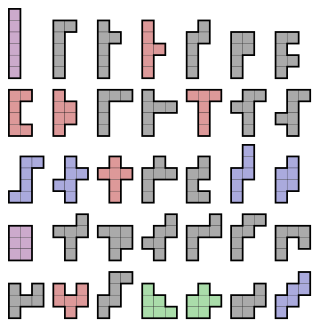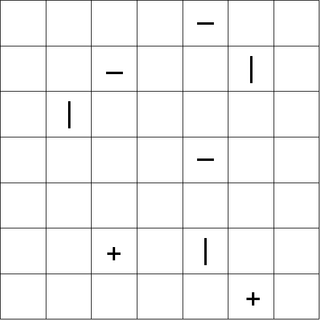Related Research Articles
The subset sum problem (SSP) is a decision problem in computer science. In its most general formulation, there is a multiset of integers and a target-sum , and the question is to decide whether any subset of the integers sum to precisely . The problem is known to be NP-hard. Moreover, some restricted variants of it are NP-complete too, for example:

A polyomino is a plane geometric figure formed by joining one or more equal squares edge to edge. It is a polyform whose cells are squares. It may be regarded as a finite subset of the regular square tiling.

Packing problems are a class of optimization problems in mathematics that involve attempting to pack objects together into containers. The goal is to either pack a single container as densely as possible or pack all objects using as few containers as possible. Many of these problems can be related to real-life packaging, storage and transportation issues. Each packing problem has a dual covering problem, which asks how many of the same objects are required to completely cover every region of the container, where objects are allowed to overlap.
The bin packing problem is an optimization problem, in which items of different sizes must be packed into a finite number of bins or containers, each of a fixed given capacity, in a way that minimizes the number of bins used. The problem has many applications, such as filling up containers, loading trucks with weight capacity constraints, creating file backups in media, and technology mapping in FPGA semiconductor chip design.
Set packing is a classical NP-complete problem in computational complexity theory and combinatorics, and was one of Karp's 21 NP-complete problems. Suppose one has a finite set S and a list of subsets of S. Then, the set packing problem asks if some k subsets in the list are pairwise disjoint.

Guillotine cutting is the process of producing small rectangular items of fixed dimensions from a given large rectangular sheet, using only guillotine-cuts. A guillotine-cut is a straight bisecting line going from one edge of an existing rectangle to the opposite edge, similarly to a paper guillotine.

Tatamibari is a type of logic puzzle designed and published by Nikoli. The puzzle is based on Japanese tatami mats.
In number theory and computer science, the partition problem, or number partitioning, is the task of deciding whether a given multiset S of positive integers can be partitioned into two subsets S1 and S2 such that the sum of the numbers in S1 equals the sum of the numbers in S2. Although the partition problem is NP-complete, there is a pseudo-polynomial time dynamic programming solution, and there are heuristics that solve the problem in many instances, either optimally or approximately. For this reason, it has been called "the easiest hard problem".
The 3-partition problem is a strongly NP-complete problem in computer science. The problem is to decide whether a given multiset of integers can be partitioned into triplets that all have the same sum. More precisely:
In computational complexity, strong NP-completeness is a property of computational problems that is a special case of NP-completeness. A general computational problem may have numerical parameters. For example, the input to the bin packing problem is a list of objects of specific sizes and a size for the bins that must contain the objects—these object sizes and bin size are numerical parameters.
In computational complexity, an NP-complete problem is weakly NP-complete if there is an algorithm for the problem whose running time is polynomial in the dimension of the problem and the magnitudes of the data involved, rather than the base-two logarithms of their magnitudes. Such algorithms are technically exponential functions of their input size and are therefore not considered polynomial.

A rectilinear polygon is a polygon all of whose sides meet at right angles. Thus the interior angle at each vertex is either 90° or 270°. Rectilinear polygons are a special case of isothetic polygons.

In the mathematical discipline of graph theory, a 3-dimensional matching is a generalization of bipartite matching to 3-partite hypergraphs, which consist of hyperedges each of which contains 3 vertices.
A geometric separator is a line that partitions a collection of geometric shapes into two subsets, such that proportion of shapes in each subset is bounded, and the number of shapes that do not belong to any subset is small.
In computational geometry, a maximum disjoint set (MDS) is a largest set of non-overlapping geometric shapes selected from a given set of candidate shapes.
In geometry, a covering of a polygon is a set of primitive units whose union equals the polygon. A polygon covering problem is a problem of finding a covering with a smallest number of units for a given polygon. This is an important class of problems in computational geometry. There are many different polygon covering problems, depending on the type of polygon being covered. An example polygon covering problem is: given a rectilinear polygon, find a smallest set of squares whose union equals the polygon.
In geometry, a partition of a polygon is a set of primitive units, which do not overlap and whose union equals the polygon. A polygon partition problem is a problem of finding a partition which is minimal in some sense, for example a partition with a smallest number of units or with units of smallest total side-length.
The strip packing problem is a 2-dimensional geometric minimization problem. Given a set of axis-aligned rectangles and a strip of bounded width and infinite height, determine an overlapping-free packing of the rectangles into the strip minimizing its height. This problem is a cutting and packing problem and is classified as an Open Dimension Problem according to Wäscher et al.
Parallel task scheduling is an optimization problem in computer science and operations research. It is a variant of optimal job scheduling. In a general job scheduling problem, we are given n jobs J1, J2, ..., Jn of varying processing times, which need to be scheduled on m machines while trying to minimize the makespan - the total length of the schedule. In the specific variant known as parallel-task scheduling, all machines are identical. Each job j has a length parameter pj and a size parameter qj, and it must run for exactly pj time-steps on exactly qj machines in parallel.
References
- ↑ Birgin, E G; Lobato, R D; Morabito, R (2010). "An effective recursive partitioning approach for the packing of identical rectangles in a rectangle". Journal of the Operational Research Society. 61 (2): 306–320. doi:10.1057/jors.2008.141. S2CID 12718141.
- ↑ Fowler, Robert J.; Paterson, Michael S.; Tanimoto, Steven L. (1981-06-13). "Optimal packing and covering in the plane are NP-complete". Information Processing Letters. 12 (3): 133–137. doi:10.1016/0020-0190(81)90111-3. ISSN 0020-0190.
- ↑ Demaine, Erik D.; Demaine, Martin L. (2007-06-01). "Jigsaw Puzzles, Edge Matching, and Polyomino Packing: Connections and Complexity". Graphs and Combinatorics. 23 (1): 195–208. doi:10.1007/s00373-007-0713-4. ISSN 1435-5914. S2CID 17190810.
- 1 2 Demaine, Erik (2015). "MIT OpenCourseWare – Hardness made Easy 2 – 3-Partition I". Youtube.
- ↑ Huang, E.; Korf, R. E. (2013-01-23). "Optimal Rectangle Packing: An Absolute Placement Approach". Journal of Artificial Intelligence Research. 46: 47–87. arXiv: 1402.0557 . doi: 10.1613/jair.3735 . ISSN 1076-9757.
- ↑ "Fast Optimizing Rectangle Packing Algorithm for Building CSS Sprites". www.codeproject.com. 14 June 2011. Retrieved 2020-09-09.
- ↑ Chan, T. M. (2003). "Polynomial-time approximation schemes for packing and piercing fat objects". Journal of Algorithms. 46 (2): 178–189. CiteSeerX 10.1.1.21.5344 . doi:10.1016/s0196-6774(02)00294-8.